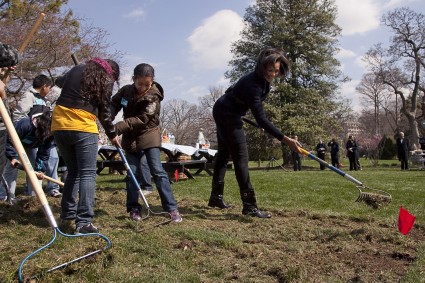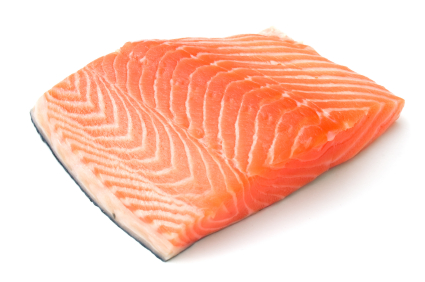 The First Lady and friends get busy in the garden. For anyone still doubting the food-related ambitions of First Lady Michelle Obama, the WaPo’s Jane Black wishes to disabuse you. In an article that charts the internal strategizing over how best to leverage the success of the White House Kitchen Garden, Black indicates that the First Lady and “the White House [are] grappling with the very issues that have challenged the so-called good food movement for decades: How do you simplify and sell a new way of eating?”
The First Lady and friends get busy in the garden. For anyone still doubting the food-related ambitions of First Lady Michelle Obama, the WaPo’s Jane Black wishes to disabuse you. In an article that charts the internal strategizing over how best to leverage the success of the White House Kitchen Garden, Black indicates that the First Lady and “the White House [are] grappling with the very issues that have challenged the so-called good food movement for decades: How do you simplify and sell a new way of eating?”
Firstly, let me say, “Welcome to the club, Mrs. Obama!” And secondly, let me observe the significance of the fact that the First Lady’s policy director Jocelyn Frye is, according to Black, deeply involved in the grapple. Frye’s role is a sign that the First Lady may intend to do some serious heavy lifting that goes beyond inspirational speeches and towards an attempt to meaningfully influence policy debates. In short, Michelle Obama is just getting started.
So what’s next? Sam Kass — the Obamas’ personal chef who is now “White House Food Initiative Coordinator” — spills the beans:
“We’re focusing on kids, even though food and health are issues we all face,” Kass said. “We want to look at the process from how and what is grown to how it gets to our plates without going in a million directions.”
A corollary to that focus is another, politically savvy choice — try to avoid directly engaging Big Ag at all costs. Don’t expect Michelle Obama to step into the decades-old battles over “agricultural subsidies, environmental regulations, nutrition standards and food labeling.”
And while August will be quiet, we should expect a new series of events come September — just as the debate of the national school lunch re-authorization heats up. No specific plans have been made but, via Black, “Obama will continue to try to link the personal to the political by gardening, cooking and eating with students.”
Still, this all begs a question. On the one hand, the First Lady understandably wants to steer clear of some of the most contentious aspects of food policy reform. But on the other, the national school lunch program encapsulates many of those battles. Big Ag will fight hard to keep the program as it is: a dumping ground for commodities with all the incentives towards serving kids the most calories for the least cost. While there is Congressional momentum to move junk food entirely out of schools, the fundamental question is how the school lunch program can serve healthier food, something for which the First Lady expresses support. Most experts believe that can only happen if Congress is willing to spend more than the current $2 per meal subsidy.
Just as health care reformers want to know where President Obama will draw his line in the sand on the health care bill, I think it’s worth wondering will Michelle Obama be drawing lines for food policy and kids comes the fall? Will she actively campaign for particular reforms? We now know from Black that Obama doesn’t view farm-to-school programs as fundamental aspects of school lunch reform. But will she endorse an increase of $1 more per meal as school lunch reforms have requested? A restoration of actual food preparation equipment to schools instead of the current reliance on heat-and-serve meals delivered directly from food processing factories?
I’m not, of course, trying to suggest that the First Lady isn’t serious about reform. She very clearly is. But it’s also clear that she’s walking a knife’s edge — a fact she and her staff obviously recognize. As everyone is painfully aware, Big Ag doesn’t play nice. Or fair for that matter. When Tom Vilsack earlier this year inelegantly suggested that legislators would have to choose between helping “rich farmers” or helping “hungry kids” when revisiting the school lunch budget, the lobbyist and industry-group pile-on that followed was as heavy-handed as it was effective.
In the end, though, Vilsack was right. Real reform will have winners and losers (unless federal pursestrings get unaccountably looser, that is). And when the debate over school lunch rages and sides are taken, I imagine that Michelle Obama will be looked to for answers. Big Ag has some of the biggest feet around — it will, I fear, be impossible for the First Lady to avoid forever stepping on their toes.
[UPDATE]: Debra Eschmeyer of the National Farm to School Network disputes Black’s dismissal of White House backing for farm-to-school efforts as well as my casting it as indicating the White House does not believe the programs are “fundamental aspects of school lunch reform.” In an email exchange, Eschmeyer observes that the article:
…does not accurately portray the Administration’s interest in scaling up the program. Black quotes Kass as stating that Farm to School is “one small piece of the larger puzzle, but it is not a priority.”
In Eschmeyer’s reading, Kass is merely admitting farm-to-school is not atop the policy list — but she asserts that it is very much in the mix.



